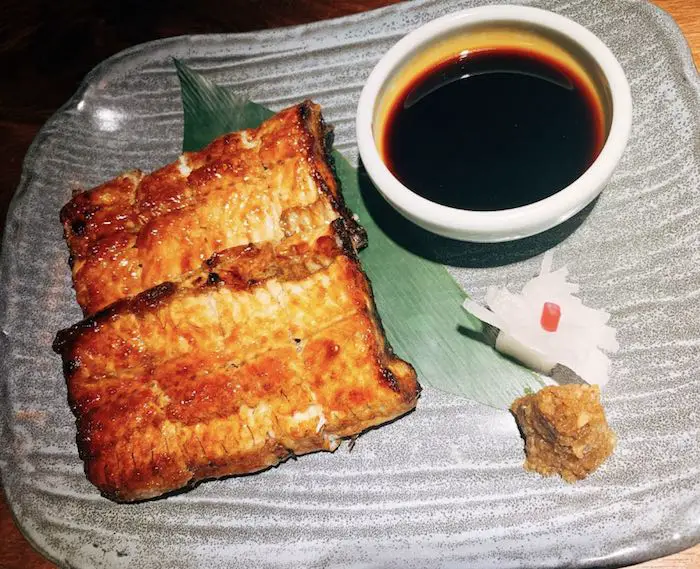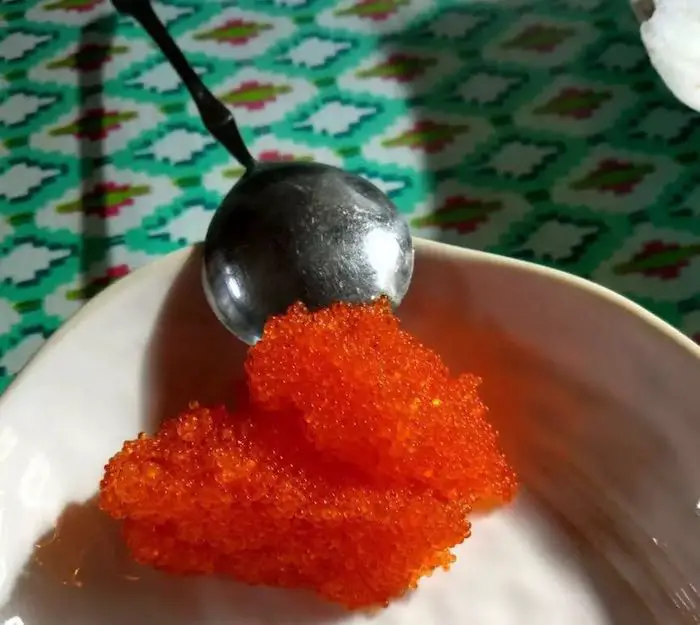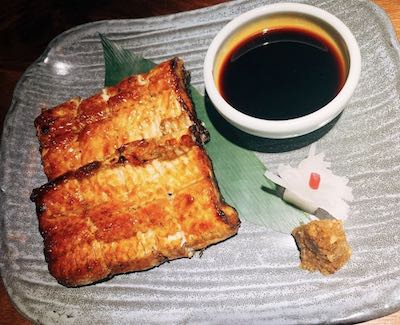We are reader supported. When you purchase through links on our site, we may earn an affiliate commission. Also, as an Amazon affiliate, we earn from qualifying purchases.

As a sushi beginner, I stayed away from trying eel sauce for several months because I thought it contained some weird stuff such as the slimy eel. Today, I can laugh off my fears because I know sushi like the back of my hand and there’s nothing eel-y about this delicious condiment. While some recipes may include a stock made of eel bones, most of them are just soy sauce, sugar, and some thickening agent.
Some people who are intolerant to gluten often ask me ‘Is eel sauce gluten free’ and my answer is not really, if you are talking about the eel sauce served in the restaurants. It is made from soy sauce and thickening agent that comprise of wheat, a primary source of starch. Thus, eel sauce is not gluten-free until it is specially made so at the restaurant or at home.
The biggest threat of ordering gluten-free sushi or sauce at the restaurant is that even if the food is gluten-free, there’s a high risk of cross-contamination. Chefs use the same knife, spoons, and cutting board for preparing gluten-free food, so tempura bits or regular soy sauce can easily come in contact. So, a person ordering gluten-free eel sauce at a sushi restaurant may end up ingesting gluten without his knowledge.
To avoid the risk of cross-contamination and stay safe, I would suggest that you prepare your own eel sauce at home. If you visit a sushi restaurant often, make it a habit to stick to raw, non-fried ingredients and carry your own gluten-free eel sauce in a small bottle. Read on to find a quick and simple recipe to make your own gluten-free eel sauce at home.
Gluten-Free Eel Sauce Recipe
Known as Unagi, Nitsume, or Kabayaki in Japanese, the eel sauce is a sweet and salty condiment that enhances the taste of grilled chicken or fish. It commonly used as a drizzle on sushi. Now, that you know the answer to ‘is eel sauce gluten free’, here is a quick recipe to make gluten-free eel sauce at home.
What you will need:
- 2 tbsp rice wine
- 2 tbsp gluten-free soy sauce
- 2 tbsp sugar or honey
- 1 tbsp corn starch or arrowroot starch
- 1 tsp fish sauce
- 1/2 cup water
Instructions
Take a small mixing bowl and add rice wine, fish sauce, honey, soy sauce. Simmer the mixture gently on low heat.
In another bowl, whisk together water and arrowroot starch to prepare a slurry mixture. Make sure the arrowroot starch dissolves completely in water.
Mix the starch solution to the simmering mixture to thicken the sauce. Once it gets a thick texture, remove from heat and let it cool. Drizzle the eel sauce over sushi.
Gluten-Laden And Gluten-Free Ingredients In Sushi
When it comes to Japanese cuisine, sushi is one of the most popular and sought after dishes people like to eat out at the restaurants. If you have celiac disease (gluten intolerance), this does not mean you have to give up the joy of eating sushi. While many people consider sushi as harmless (it contains only rice, raw fish, and veggies after all!), there’s gluten hidden in its various ingredients.
If you are eating out, make sure you let the chef and server know that you are on a gluten-free diet. Most of the restaurants are adept at meeting the special diet requirements. You must also be careful about what you order to ensure that you stay safe. Here’s a breakdown of the gluten-laden and gluten-free ingredients used in sushi.
Sushi rice or shari: While rice appears like a humble and safe ingredient, please be aware that some restaurants may add a special binding agent to season sushi rice. This could be vinegar or Japanese broth that may contain wheat. Hence, I would recommend that you ask the server if the rice used for preparing sushi is gluten-free.
Imitation Crab: I know this seems like such an easy to use and cheap alternative to real crab meat, but this readymade sushi filling has no crab at all, only crab flavoring. Instead, it is made from processed parts of several species of white fish mixed with a binding agent. The mixture is dyed to make it resemble crab meat, however, the binding agent contains wheat and this makes it gluten-laden.

Wasabi: Real wasabi paste (see how to make it) is made by grating the rhizome of the wasabi plant, however, it’s hard to get real wasabi paste in sushi restaurants. Most chefs use horseradish, mustard, and food coloring to replicate the same taste and appearance. It may be mixed with flour or corn starch to hold the ingredients together, hence it is not gluten free.
Tempura: If you are on a celiac diet, you must stay away from anything that is fried and crispy, most importantly tempura. This may include fish, seafood, or vegetables battered in flour and then deep-fried in oil. The batter mostly contains wheat flour, hence it is not gluten free. There are some restaurants that may use a gluten-free batter to make tempura and label it appropriately on the menu, so remember to ask before ordering.
Spicy Mayo: Any item on the menu such as spicy tuna that contains mayonnaise has the risk of containing gluten in the form of thickeners and vinegar. Some restaurants cover the needs of people on a special diet and use gluten-free mayo for preparing the dishes, so make sure you ask the chef or server.
Soy Sauce: Japanese cuisine is incomplete without the use of soy sauce, and most of the brands inevitably contain wheat in it. Thankfully, gluten-free soy sauce such as tamari is fast becoming popular in sushi restaurant to cater to the needs of people on a celiac diet. I recommend you to carry your own travel pack of tamari sauce in case the restaurant does not have it.
Teriyaki Sauce: This is another type of popular sushi condiment that you should stay away from because it contains wheat, an unsafe ingredient for people with celiac disease. Similarly, there is another sauce called Ponzu Sauce, which is made from soy sauce that again contains wheat.

Masago/ Tobiko: While the fish eggs are mostly a gluten-free item, the chef may marinate it with soy sauce or mayo, so make sure you ask before ordering any dish containing masago or tobiko.
Marinades: It is common for chefs to marinate fish before rolling it up in your sushi roll, but that marinade may contain sauces that have wheat as a primary component. Hence, avoid anything that has been marinated unless the menu mentions clearly that it is gluten-free.
Eating Out Is A Challenge For People With Gluten-Intolerance
It’s all about that little bit of protein that holds wheat together and it’s much easier to avoid today than it used to be some years ago. If you are willing to spend more, you can find a plethora of gluten-free items on the grocery stores and health food stores. Dining out still poses some challenges for those who are gluten-intolerant.
Sushi offers a lot of options for people looking for a special celiac diet. From unseasoned sushi rice and raw fish slices (sashimi) to miso soup and salads, there are so many items to choose from. While soy sauce and other soy-based condiments such as eel sauce, teriyaki, ponzu sauce contain gluten, you may still find restaurants that offer gluten-free alternatives.
If you have plans to dine out for a special date or a birthday bash, always call the restaurant beforehand to inquire if they can accommodate special requirements for a gluten-free diet. There are some restaurants where chefs are happy to use a tamari base instead of soy sauce, thus opening up a lot more options for you.
Unlike yesteryears, the gluten-free movement has spread considerably due to the increasing number of people who have given up gluten for its associated health benefits, people who are intolerant to gluten, and those who have celiac disease. Thus, it boils down to a simple equation of supply and demand.
Even if a restaurant does not have many gluten free options, they may be willing to make changes to accommodate the dietary restrictions. We are hopeful that the scenario will improve significantly in the future with more sushi restaurants offering gluten free options.
Tips To Enjoy Safe And Gluten-Free Sushi In Restaurant
#1. Always inquire if they have any gluten-free options, at least tamari sauce instead of the traditional soy sauce. In case, they don’t, remember to always carry little packets of gluten-free sauce.
#2. Avoid anything that is fake or imitation because they will mostly include some form of binding agent that will contain wheat in it.
#3. Request the sushi chef to use a new bamboo mat to make your sushi. Please make a humble request instead of sounding rude and 9 out of 10 chefs will honor your request.
#4. You may also request the sushi chef to change his gloves, knife and other tools stating your gluten-intolerance and the risk of cross-contamination from using the same tools.
#5. When you are served gluten-free sushi, avoid drizzling extra sauces unless you are sure that it does not contain wheat.
#6. Request your food to be served separately to you. Eating from a sushi boat may increase the risk of cross contamination.
Related Questions
How to look for restaurants that offer gluten-free sushi
Check the online customer reviews on websites like Yelp to find sushi restaurants that serve gluten free food in your area. If you know of a place that does, make sure you help others like you by leaving a review about it.
Is eel sauce vegan?
Yes, the authentic eel sauce does not contain any fish stock, hence it is purely vegan and safe to eat for people on a vegan or vegetarian diet. I have created an article that contains more information on eel sauce and its different vegan variations, check it out here.
Where can I find gluten free eel sauce?
If you have severe intolerance for gluten, I would recommend that you make your own gluten-free eel sauce at home because this will rule out any risk of cross-contamination. If you don’t have the time to cook, consider buying the Otajoy Gluten Free Sushi Sauce from Amazon.
See Also: What Is The Orange Sauce On Sushi?

